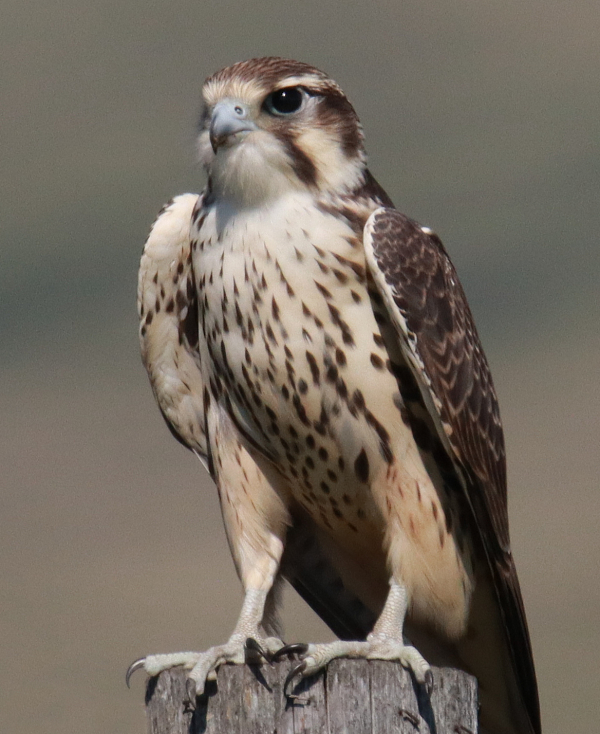
Early in the photo session, I took a series of 3 consecutive photos that provided simple changes in view of the attractive young Prairie Falcon, looking left (above), forward (below), and right (all the falcon photos were taken using a 600mm zoom lens, f-9 aperture, 1/2500 shutter speed, 800 ISO).
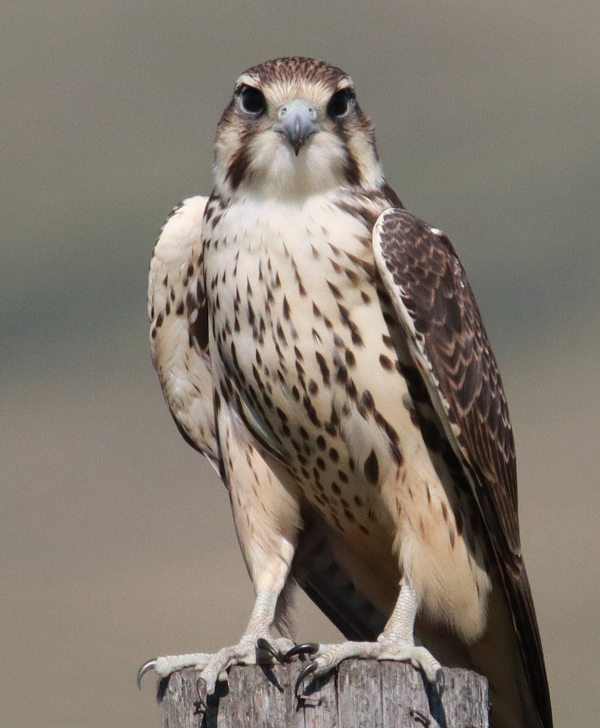
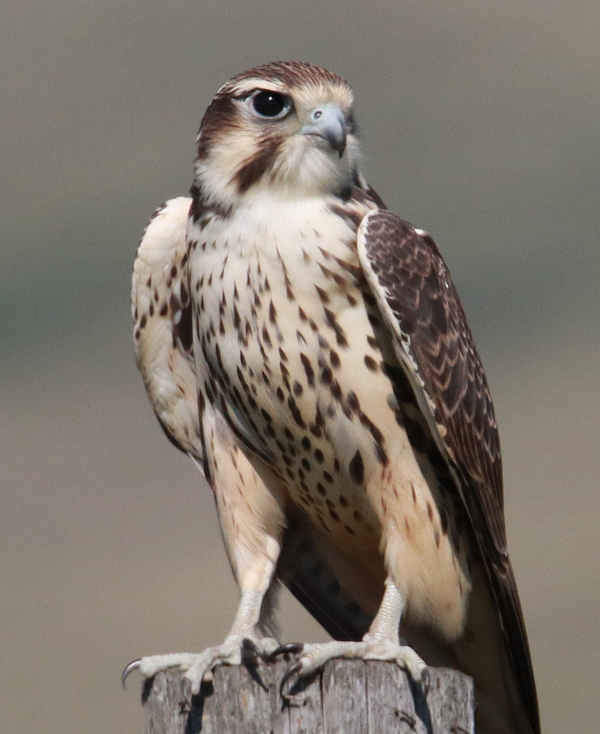
In addition to other features of this impressive bird of prey, notice the large size of the feet, which are indicative of a female raptor.
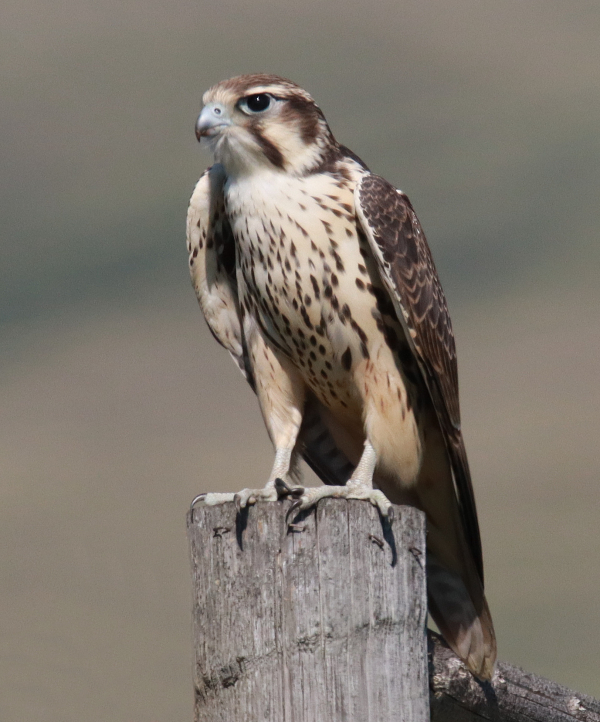
Here you see the full length of the young female Prairie Falcon including its tail. I made the decision to crop the tail and most of the post from the first 3 photographs to better emphasize the bird.
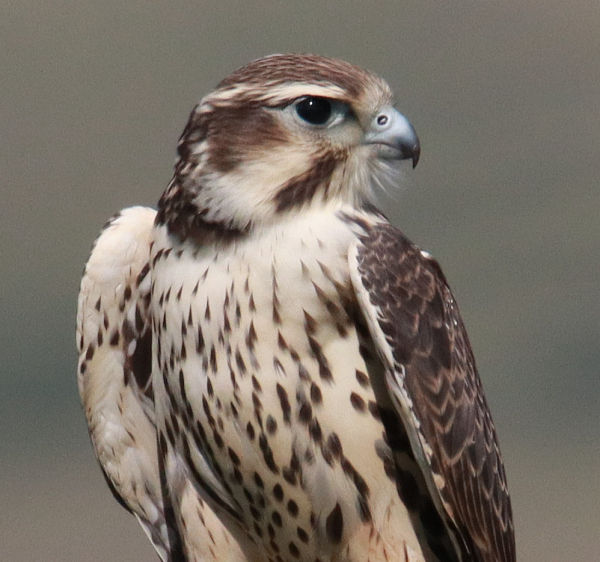
In this close portrait, note the light-blue color of the cere above the beak, the beak itself, and the orbital skin surrounding the eye, all of which underline the fact that this is a first-year Prairie Falcon. After the first year the cere, orbital skin, legs, and feet are yellow.

Few photographs of the backside of a Prairie Falcon’s head have been published over the years, for obvious reasons, but we couldn’t resist including this one to give you a different look at this interesting species. The markings in the head plumage may resemble a face to help to protect its backside when its head is turned.
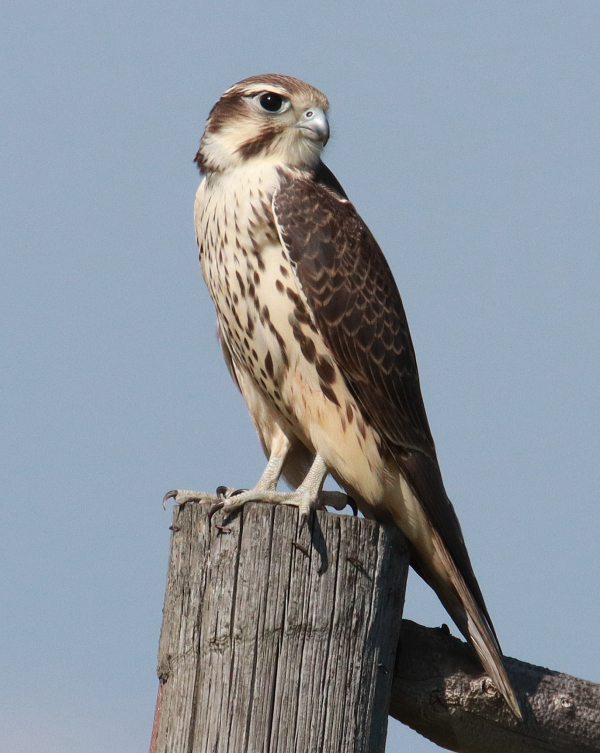
When I allowed my mobile blind (car) to coast a few feet downhill and to the left, I was able to generate a side view of the Prairie Falcon with a blue sky background, which gives the impression of an entirely different bird and setting.
|
One of the great things about birding is that it is full of surprises, and it was just such a surprise that made an enjoyable, productive birding drive an especially memorable outing. Having just visited the Ferruginous Hawk nesting territory, where I took documentary photos of the adult female and male, I checked for any sign of the fledglings and saw none. About 5 miles farther north, as I drove up a high hill I saw a raptor perched on a fencepost at the top and immediately noticed it was a bit on the small side to be one of the Buteo hawks so commonly encountered now. But common this bird was not! A Prairie Falcon sighting is always an exciting surprise, wherever I see one, and in this case it was just 25 miles from home as the falcon flies.
I continued past the impressive falcon to double-check for any vehicles on the road to the north or south, then checked my camera settings and turned around. The Prairie Falcon didn’t flinch as I approached, turned off my engine and coasted into position with my window open and camera pre-focused on the fenceline, hoping the falcon would provide at least one fine photograph – and she did! Without a hint of concern, the Prairie Falcon provided a series of portraits that I could only hope for in my dreams. Usually, Prairie Falcons perch on the tallest pole or treetop so previous images have been taken from a lower angle; but this Prairie was perched at eye level, and I was literally photographing it while looking eye to eye – woowee!
This was an especially beautiful Prairie Falcon, its plumage unblemished, as were its beak and feet – indicators that this was a fairly new fledging that was hundreds of miles east of the closest known nesting eyrie for this spectacular western species. Prairies are known to venture into the Missouri Coteau region to chase migrating shorebirds after the nesting season, but some years I don’t see one, and I rarely see more than one per summer. Any falcon is a special bird, and Prairie Falcons are captivating for this birder and most others when they have a chance to see one, especially at close range.
This Prairie Falcon was on the small side, so I imagined it was a male, but when I saw the size of its feet, I changed my vote to a small female. Her feet were large for any Prairie Falcon, and female birds of prey tend to have larger feet and tend to be larger in size than males. That aside, she was very photogenic, although pretty stationary, which was fine – she shared a peaceful feeling that was also a reflection of the surrounding green prairie hills.
On the technical side of photographing during what turned out to be a portrait session, the sun was at my back, I used an f-9 aperture, which provided a fast shutter speed to create sharp images of the mostly stationary young falcon. I thought about dialing the aperture down to f-7 or f-6, but the big hills in the background were almost a mile away, so there was little chance they would be in focus at f-9. After a while, the falcon found something of interest behind it and rivaled an owl in its ability to twist its neck in reverse. I even took a couple photos of it in that position to show the pattern of the feathers on the back of its head.
Eventually, I allowed my car to coast farther forward, hoping to get more of the Prairie’s wing and tail plumage in the photo frame, and to position so the falcon had a blue sky background. That position change made quite a difference in the ensuing photos, but that’s when the Prairie Falcon turned toward the point of interest behind her, showing me her backside and creating a shadow on her face. Now I was ready for action, just in case she took flight – and she did. I tried to follow her within my camera view, but she stayed very low to the ground and vanished behind a bend in the hill.
I watched for her to reappear in the open valley below, or to rise up into the blue sky, but even when I drove forward to survey other potential perches while watching for movement, not another hint of this rare visitor to the east was revealed. How fun that meeting and photo association was, and how happy I am to have the resulting photographs, with the added opportunity to share them with you along with some insights about the bird, the species, and the photo fun. Thanks in a big way for taking a look at these Prairie Falcon portraits and for reading my article! Please return next week – I’m sure to have new photos and notes to share that should help you in your own bird photography endeavors.
Article and Photographs by Paul Konrad
Share your bird photos and birding experiences at editorstbw2@gmail.com